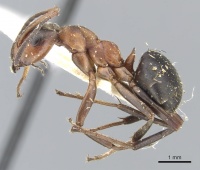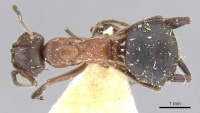Formica mesasiatica
| Formica mesasiatica | |
|---|---|

| |
| Scientific classification | |
| Kingdom: | Animalia |
| Phylum: | Arthropoda |
| Class: | Insecta |
| Order: | Hymenoptera |
| Family: | Formicidae |
| Subfamily: | Formicinae |
| Tribe: | Formicini |
| Genus: | Formica |
| Subgenus: | Coptoformica |
| Species: | F. mesasiatica |
| Binomial name | |
| Formica mesasiatica Dlussky, 1964 | |
This species is found in steppe-like or semidry grasslands and woodland clearings. The highest densities were found in grasslands with shrub. Monodomous isolated nests as well as polydomous colonies were observed. Nuptial flights are delayed with growing elevation and were observed in Middle Asia between 29 June and 8 August. (Tyanshan and N Pamir; Seifert & Schultz, 2021).
| At a Glance | • Temporary parasite |
Identification
Seifert (2000) - F. mesasiatica shows highly significant (p < 0.0001) differences to Formica exsecta in sqrtPDG, sqrtPDH, and nCOXA of queens and workers and in SL/CL of queens. However, it cannot be completely separated from exsecta by discriminant functions even on the basis of nest sample means. Because of the very peculiar zoogeographic situation - the only Coptoformica species known from Middle Asia (Tyanshan and N Pamir) and the population is apparently fully isolated from the Palaearctic range of exsecta - mesasiatica is treated here as species.
Distribution
Seifert (2000) - Limited to the mountain areas of the Tyanshan and N Pamir.
Distribution based on Regional Taxon Lists
Palaearctic Region: China, Russian Federation (type locality).
Distribution based on AntMaps
Distribution based on AntWeb specimens
Check data from AntWeb
Countries Occupied
| Number of countries occupied by this species based on AntWiki Regional Taxon Lists. In general, fewer countries occupied indicates a narrower range, while more countries indicates a more widespread species. |

|
Estimated Abundance
| Relative abundance based on number of AntMaps records per species (this species within the purple bar). Fewer records (to the left) indicates a less abundant/encountered species while more records (to the right) indicates more abundant/encountered species. |

|
Habitat
Found on steppe-like or semidry grasslands and woodland clearings between 1300-2700 m (Dlussky 1967; Tarbinsky 1976; Schultz pers. comm.). The highest densities were observed in grasslands with bushes.
Biology
As a member of the subgenus Coptoformica this species is likely to be a temporary parasite of another species of Formica, but its host is unknown.
Flight Period
| X | X | X | |||||||||
| Jan | Feb | Mar | Apr | May | Jun | Jul | Aug | Sep | Oct | Nov | Dec |
Source: Seifert & Schultz, 2021.
- Check details at Worldwide Ant Nuptial Flights Data, AntNupTracker and AntKeeping.
 Explore: Show all Flight Month data or Search these data. See also a list of all data tables or learn how data is managed.
Explore: Show all Flight Month data or Search these data. See also a list of all data tables or learn how data is managed.
Association with Other Organisms
 Explore: Show all Associate data or Search these data. See also a list of all data tables or learn how data is managed.
Explore: Show all Associate data or Search these data. See also a list of all data tables or learn how data is managed.
- This species is a host for the trematode Dicrocoelium dendriticum (a parasitoid) (Quevillon, 2018) (encounter mode primary; indirect transmission; transmission outside nest).
Castes
Queen
Images from AntWeb
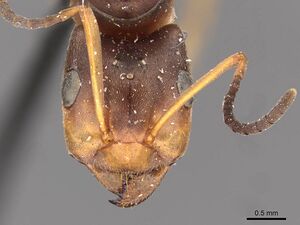   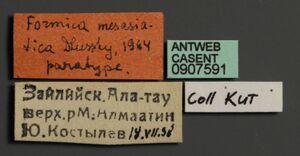 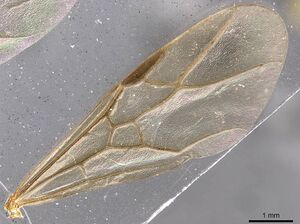 
| |
| Paratype of Formica mesasiatica. Queen (alate/dealate). Specimen code casent0907591. Photographer Z. Lieberman, uploaded by California Academy of Sciences. | Owned by MZL, Lausanne, Switzerland. |
Nomenclature
The following information is derived from Barry Bolton's Online Catalogue of the Ants of the World.
- mesasiatica. Formica (Coptoformica) mesasiatica Dlussky, 1964: 1030, figs. (w.q.m.) RUSSIA. Junior synonym of fukaii: Sonobe & Dlussky, 1977: 23. Revived status as species: Seifert, 2000a: 532. See also: Tarbinsky, 1976: 179.
Unless otherwise noted the text for the remainder of this section is reported from the publication that includes the original description.
Description
Worker
Seifert (2000) - Very large (CL 1468 ± 61, 1359-1582; CW 1414 ± 61, 1321-1535). Head shape as in Formica exsecta (CL/CW 1.038 ± 0.014, 1.002-1.061). Scape long (SL/CL 1.027 ± 0.019, 0.989-1.059). Clypeus also in median and posterior portions with standing setae (ClySet 4.22 ± 0.43,4-5). Lateral semierect setae in the ocellar triangle always present (OceSet 100%). Eye hairs always strongly developed, often hook-shaped (EyeHL 35.7 ± 4.6, 30-47). Pubescence in the occellar triangle always very dense (sqrtPDF 3.99 ± 0.22, 3.58-4.41). Occipital corners in contrast to the exsecta standard with almost appressed pubescence. Craniad profile of forecoxae with few semierect setae (nCOXA 4.58 ± 0.90, 3.0-5.5). Dorsal pronotum and propodeum occasionally, lateral metapleuron and ventrolateral propodeum always with few standing setae (nMET 3.61 ± 1.26, 1.5-6.0). Outer edge of hind tibial flexor side conspicuously hairy (nHTFL 9.50 ± 0.99, 8.0-11.0), with two size classes of setae, and subdecumbent pubescence. Semierect setae on gaster tergites beginning on the first tergite (TERG 1.00 ± 0.0). Pubescence distance on first gaster tergite very low (sqrtPDG 4.43 ± 0.65, 3.72-6.14).
Queen
Seifert (2000) - As large as exsecta (CL 1642 ± 33, 1585-1687; CW 1721 ± 22, 1697-1765; ML 2949 ± 79, 2831-3040). Head broad (CL/CW 0.955 ± 0.023, 0.926-0.985), scape significantly longer than in exsecta (SL/CL 0.994 ± 0.023, 0.957-1.024). Clypeus also in posterior portions with standing setae. Lateral semierect setae in the ocellar triangle usually present. Eye hairs always long and numerous, often hook-shaped (EyeHL 49.2 ± 6.2, 40-55). Pubescence in the occellar triangle always very dense (sqrtPDF 3.56 ± 0.20, 3.33-3.85). Occipital corners of head with decumbent or subdecumbent hairs (OccHD 38.5 ± 9.3, 31-59); queens with appressed hairs are reported to occur (Dlussky 1967). Brilliance of dorsal head surface low, weakly sculptured surfaces dominate (GLANZ 1.41 ± 0.38, 1.0-2.0). Craniad profile of forecoxae with semierect setae (nCOXA 8.06 ± 1.52, 6.0-11.0). Promesonotum always with standing setae that clearly differ from semierect pubescence (MnHL 195.3 ± 29.2, 152-233). Outer edge of the hind tibial flexor side conspicuously hairy (nHTFL 9.43 ± 2.87, 6.0-15.0), with two size classes of setae and subdecumbent pubescence. Semierect setae on gaster tergites always beginning on the first tergite (TERG 1.00 ± 0.00). Pubescence distance on first gaster tergite constantly very low (sqrtPDG 3.56 ± 0.20, 3.33-3.85).
Type Material
Talasskiy Alatau and Zailiyskiy Alatau, Tyanshan. Paratype (Musée de Zoologie, Lausanne).
References
- Borowiec, M.L., Cover, S.P., Rabeling, C. 2021. The evolution of social parasitism in Formica ants revealed by a global phylogeny. Proceedings of the National Academy of Sciences 118, e2026029118 (doi:10.1073/pnas.2026029118).
- Dlussky, G. M. 1964. The ants of the subgenus Coptoformica of the genus Formica (Hymenoptera, Formicidae) of the USSR. Zool. Zh. 4 43: 1026-1040 (page 1030, figs. worker, queen, male described)
- Goropashnaya, A.V., Fedorov, V.B., Seifert, B., Pamilo, P. 2012. Phylogenetic relationships of Palaearctic Formica species (Hymenoptera, Formicidae) based on mitochondrial Cytochrome b sequences. PLoS ONE 7, e41697 (doi:10.1371/journal.pone.0041697).
- Seifert, B 2000a. A taxonomic revision of the ant subgenus Coptoformica Mueller, 1923 (Hymenoptera: Formicidae). Zoosystema 22:517-568. (page 532, Revived status as species)
- Seifert, B., Schultz, R. 2021. A taxonomic revision of the Palaearctic ant subgenus Coptoformica Müller, 1923 (Hymenoptera, Formicidae). Beiträge zur Entomologie 71 (2): 177–220 (doi:10.21248/contrib.entomol.71.2.177-220).
- Sonobe, R. and Dlussky, G. M. 1977. On two ant species of the genus Formica (Hymenoptera, Formicidae) from Japan. Kontyû. 45:23-25 (page 23, Junior synonym of fukaii)
- Tarbinsky, Y.S. 1976. The ants of Kirghizia. Frunze: Ilim, 217 pp. (page 179, see also)
References based on Global Ant Biodiversity Informatics
- Guénard B., and R. R. Dunn. 2012. A checklist of the ants of China. Zootaxa 3558: 1-77.
- Marikovsky P. I. 1979. Ants of the Semireche Desert. [In Russian.]. Alma Ata: Nauka, 263 pp.
- Ran H., and S. Y. Zhou. 2012. Checklist of chinese ants: formicomorph subfamilies (Hymenoptera: Formicidae) II. Journal of Guangxi Normal University: Natural Science Edition 30(4): 81-91.
- Schultz R., and B. Seifert. 2007. The distribution of the subgenus Coptoformica Müller, 1923 (Hymenoptera: Formicidae) in the Palaearctic Region. Myrmecological News 10: 11-18.
- Seifert B. 2000. A taxonomic revision of the ant subgenus Coptoformica Mueller, 1923 (Hymenoptera, Formicidae). Zoosystema 22: 517-568.
- Wu wei, Li Xiao Mei, Guo Hong. 2004. A primary study on the fauna of Formicidae in Urumqi and its vicinities. Arid Zone Research 21(2): 179-182
- Pages using DynamicPageList3 parser function
- Temporary parasite
- Need species key
- Ant Associate
- Host of unknown
- FlightMonth
- Trematode Associate
- Host of Dicrocoelium dendriticum
- Species
- Extant species
- Formicidae
- Formicinae
- Formicini
- Formica
- Coptoformica
- Formica mesasiatica
- Formicinae species
- Formicini species
- Coptoformica species
- Formica species
- Ssr
